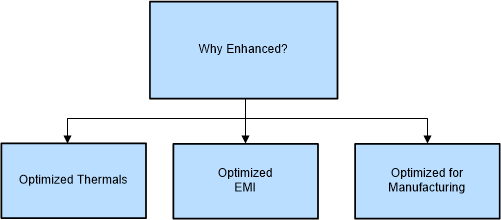-
Enhanced HotRod QFN Package: Achieving Low EMI Performance in Industry’s Smallest 4-A Converter SNVA935A June 2020 – July 2021 LM60430 , LM60430-Q1 , LM60440 , LM60440-Q1
-
Enhanced HotRod QFN Package: Achieving Low EMI Performance in Industry’s Smallest 4-A Converter
Enhanced HotRod QFN Package: Achieving Low EMI Performance in Industry’s Smallest 4-A Converter
Trademarks
HotRod are trademarks of Texas Instruments.
PowerPad is a trademark of Texas Instruments.
All trademarks are the property of their respective owners.
1 Introduction
Enhanced HotRod QFN is the latest advancement in semiconductor packaging which enables the industry's smallest 4-A, 36-V step-down converter. Figure 1-1 shows the semiconductor packaging technology evolution for high-power density step-down converters. The LM43603 was developed in a leaded HTSSOP package which uses a ground DAP for optimal thermal dissipation through the bottom side of the package. Second, the LMR23630 was released in a standard QFN package to eliminate the external leads while still having a thermal DAP. Consequently, the LMR23630 package size decreased by 73% compared to the previous generation converter. Third, the flip-chip on lead-frame (FCOL) technology has further improved the package-to-die ratio and removed package wirebonds connecting die to lead-frame to provide best-in-class noise performance. The Enhanced HotRod QFN package leverages the noise improvements of the FCOL package (Section 2) and the thermal advantages of the standard QFN package (Section 4). Figure 1-2 highlights the enhancements from FCOL and standard QFN packages to 'Enhanced' QFN. The latest TI part developed with Enhanced HotRod QFN package technology is the LM60440 device. It has a 4-A output current capability in an ultra-small 3-mm × 2mm package.
 Figure 1-1 Texas Instruments Package
Evolution
Figure 1-1 Texas Instruments Package
Evolution Figure 1-2 Feature Set of Enhanced HotRod
QFN
Figure 1-2 Feature Set of Enhanced HotRod
QFN2 Enhanced HotRod QFN – Optimized EMI Performance
2.1 Introduction
MOSFET technologies for wide input DC/DC converters enable the design of fast switching and high-efficiency power systems. Consequently, the latest DC/DC converters lead to fast switch voltage slew rates (dv/dt) and high-current slew rates (di/dt) which exacerbates the EMI emissions from a switch mode power supply and can cause problems to peripheral modules. For more details on the sources of EMI in DC/DC converters see the EMI Guide technical article series. EMI filters are inevitably part of a power electronic system, but since filtering adds unwanted size and cost, it is incumbent on the designer to look for all possible avenues including package technology for EMI noise reduction and mitigation. Regulatory compliance to electromagnetic compatibility (EMC) standards—for example, CISPR 32 for multimedia equipment and CISPR 25 for automotive applications is vitally important, as the efforts required to achieve compliance affect both product development costs and time to market. CISPR-25 is one of the most stringent emission standards for vehicles and devices targeting radio disturbance characteristics. The limits and methods of measurements are intended to protect onboard receivers from disturbances produced by components, such as a switching regulator in a power-supply design. For a deeper understanding of CISPR and other emission standards, see An overview of conducted EMI specifications for power supplies and An overview of radiated EMI specifications for power supplies white papers.
Low-EMI switching regulators utilize package technology, optimized pin-outs, and layout guidelines to minimize conducted and radiated noise from DC/DC converters which can enhances power system's performance to meet stringent EMI standards. TI's latest converter, LM60440, leverages the latest Enhanced HotRod QFN technology, and the pinout and package of the LM60440 regulator have been diligently optimized to minimize the parasitic inductance of switching loops to achieve the best-in-class low-noise performance.